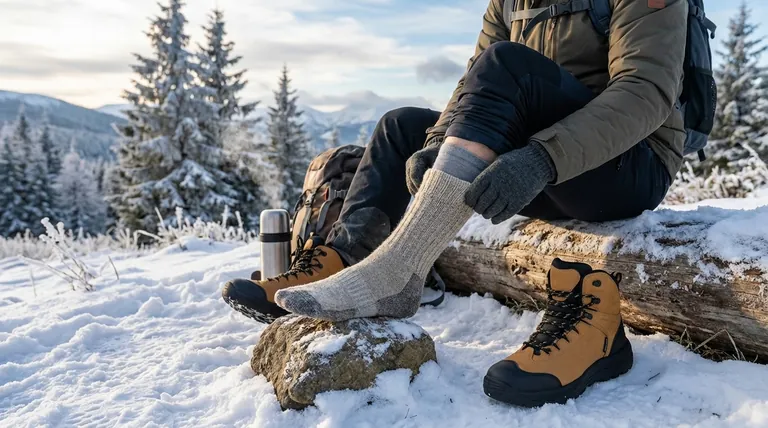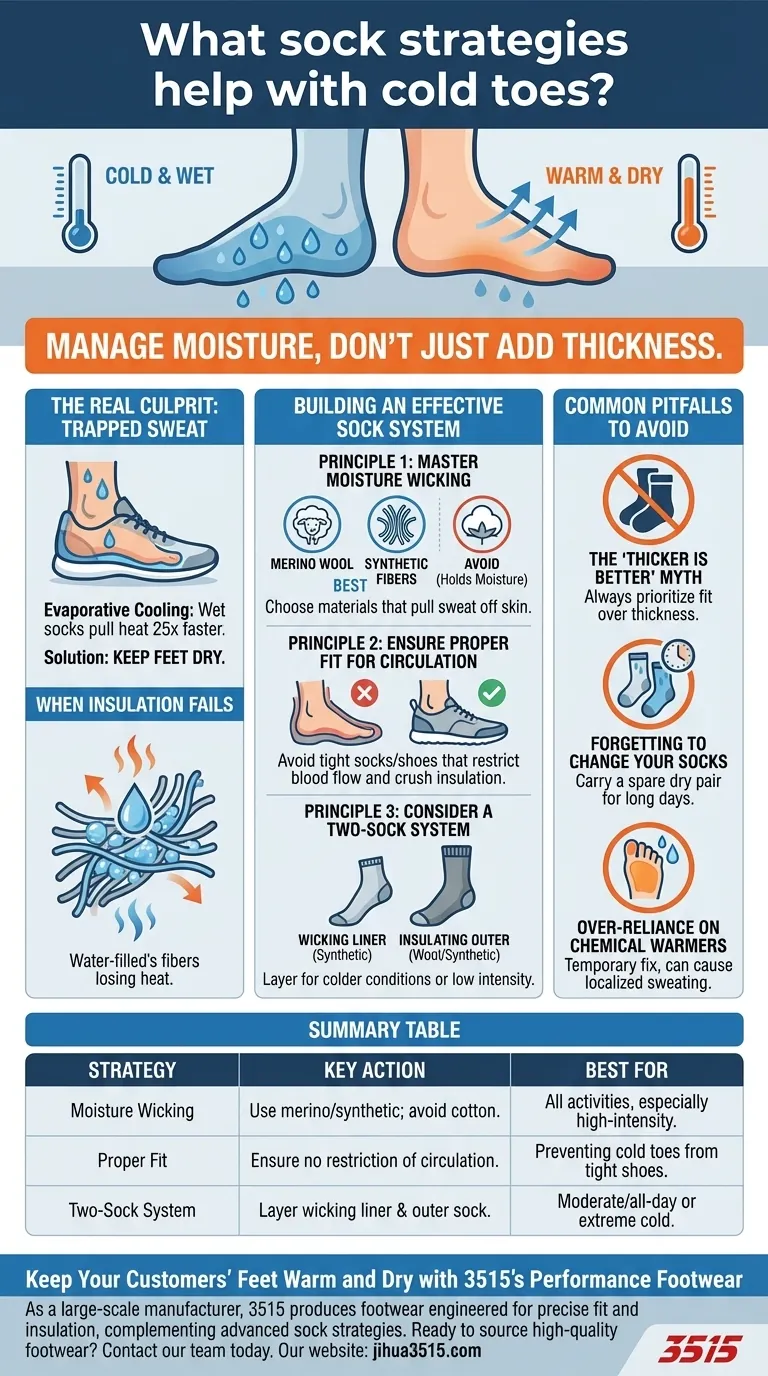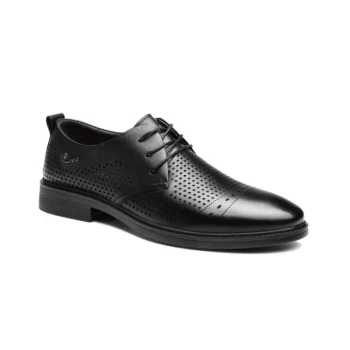The most effective sock strategy for cold toes focuses on managing moisture, not simply on adding thickness. The solution involves using moisture-wicking materials that keep your skin dry, ensuring a proper fit that doesn't restrict circulation, and layering intelligently both inside and outside your footwear.
Cold toes are rarely caused by a lack of insulation alone; they are almost always the result of trapped sweat. Once your sock becomes damp, it rapidly pulls heat away from your skin. Therefore, the single most important goal is to keep your feet dry.

The Real Culprit: Why Your Toes Get Cold
To solve the problem of cold toes, you must first understand the underlying cause. The issue is less about the outside temperature and more about the microclimate inside your shoe.
The Problem Isn't Cold, It's Moisture
Your feet have one of the highest concentrations of sweat glands in your body. Even in cold weather, they produce moisture.
When this sweat is trapped in your sock, it causes evaporative cooling. The moisture pulls heat away from your skin up to 25 times faster than dry air, leaving your toes feeling frozen even if the rest of your body is warm.
When Insulation Fails
A dry sock traps air between its fibers, creating an insulating barrier. This trapped air slows the transfer of heat away from your foot.
However, once a sock becomes wet, that air is replaced with water. Water is an excellent conductor of heat, so the wet sock loses its insulating properties and actively works to make your foot colder.
Building an Effective Sock System
A successful strategy is a complete system that manages moisture, preserves blood flow, and protects you from the elements.
Principle 1: Master Moisture Wicking
The material of your sock is the most critical factor. Your goal is to choose a fiber that pulls sweat off your skin and moves it to the outer surface of the sock where it can evaporate.
Merino wool and high-quality synthetic fibers (like polyester or polypropylene blends) are the best choices. They absorb very little water and retain their insulating properties even when damp.
Crucially, you must avoid cotton at all costs. Cotton absorbs and holds onto moisture, creating the perfect conditions for heat loss.
Principle 2: Ensure Proper Fit to Maintain Circulation
A common mistake is choosing a sock that is too thick for your shoe. This creates two significant problems.
First, it compresses your foot, restricting the blood flow that delivers warmth to your toes. If warm blood can't get to your extremities, they will get cold regardless of insulation.
Second, it compresses the sock's fibers, squeezing out the trapped air that provides insulation. A crushed sock cannot do its job.
Principle 3: Consider a Two-Sock System
For colder conditions or lower-intensity activities, layering can be highly effective. This involves wearing two pairs of socks.
The inner layer should be a very thin, snug-fitting liner sock made of a high-performance synthetic material designed to wick moisture directly off the skin.
The outer layer should be a slightly thicker wool or synthetic sock that provides the primary insulation and helps pull moisture away from the liner.
Common Pitfalls to Avoid
Even with the right materials, simple mistakes can undermine your efforts to stay warm.
The "Thicker is Better" Myth
Do not assume a thicker sock is always warmer. A bulky sock that makes your shoes tight is one of the fastest ways to get cold feet. Always prioritize fit over thickness.
Forgetting to Change Your Socks
On long excursions, your socks will eventually become damp with sweat, no matter how good they are.
For full-day activities like cycling or hiking, carrying a spare pair of dry socks is a professional-grade strategy. Swapping them out mid-day can completely reset your system.
Over-reliance on Chemical Warmers
Chemical toe warmers can be a useful tool, but they are a temporary fix, not a systemic solution.
They can sometimes cause localized sweating where they contact the sock. When the warmer dies, this new moisture can lead to your feet feeling even colder than before.
How to Choose Your Strategy
Your ideal setup depends on your activity level and the conditions.
- If your primary focus is high-intensity activity (e.g., winter running, cycling): Prioritize a single, thin, highly moisture-wicking sock. Your body is generating ample heat; your only enemy is sweat.
- If your primary focus is moderate, all-day activity (e.g., hiking, skiing): Use a two-sock system with a thin wicking liner and a medium-weight wool or synthetic outer sock.
- If your primary focus is low-intensity activity or extreme cold (e.g., ice fishing, standing outdoors): Combine a two-sock system with well-insulated boots and consider adding external insulation like boot covers to protect the entire system.
By shifting your focus from adding thickness to managing moisture, you can build a system that guarantees warm feet in any condition.
Summary Table:
| Strategy | Key Action | Best For |
|---|---|---|
| Moisture Wicking | Use merino wool or synthetic socks; avoid cotton. | All activities, especially high-intensity. |
| Proper Fit | Ensure socks are not too thick, avoiding restricted circulation. | Preventing cold toes caused by tight shoes. |
| Two-Sock System | Layer a thin synthetic liner under a medium-weight outer sock. | Moderate all-day activities (hiking, skiing) or extreme cold. |
Keep Your Customers' Feet Warm and Dry with 3515's Performance Footwear
As a large-scale manufacturer, 3515 produces a comprehensive range of footwear for distributors, brand owners, and bulk clients. Our production capabilities encompass all types of shoes and boots designed to work in perfect harmony with these advanced sock strategies.
We understand that warm feet depend on a complete system. Our boots are engineered with the precise fit and insulation needed to maximize the effectiveness of moisture-wicking socks, ensuring ultimate comfort and performance for the end-user.
Ready to source high-quality footwear that complements these warm-feet strategies? Contact our team today to discuss your manufacturing needs and how we can help you deliver superior products to your market.
Visual Guide

Related Products
- Premium Insulated Safety Boots and Shoes for Wholesale & Bulk Orders
- Safety Footwear Wholesale Manufacturer for Custom OEM/ODM Production
- Wholesale Comfortable Business Casual Shoes Custom Manufacturing
- Custom Manufactured Air Cushion Leather Business Shoes for Wholesale
- Wholesale Modern Comfort Shoes with Dial Closure for Private Label & Bulk Orders
People Also Ask
- What is Thinsulate and how does it function in insulated boots? Achieve Superior Warmth Without Bulk
- Why is it important to keep feet dry during winter? Prevent Frostbite & Infections
- What additional protective footwear feature might be beneficial for construction workers in cold climates? Choose Composite Toe for Superior Warmth
- What features should one look for when selecting supportive winter footwear? Secure Your Stride with the Right Support
- What is the best way to protect feet from frostbite in winter? A Complete System for Dry, Warm Feet



















